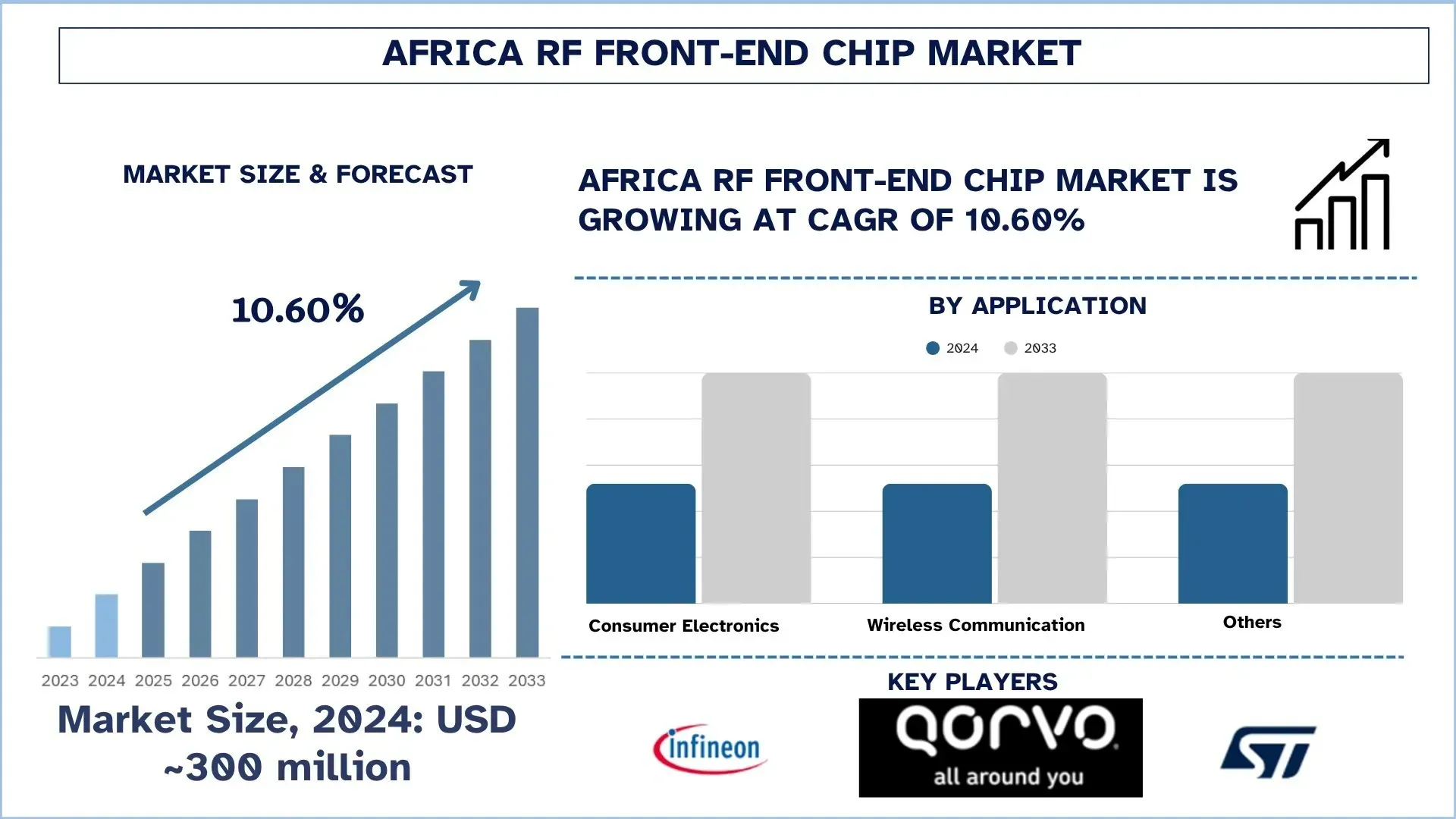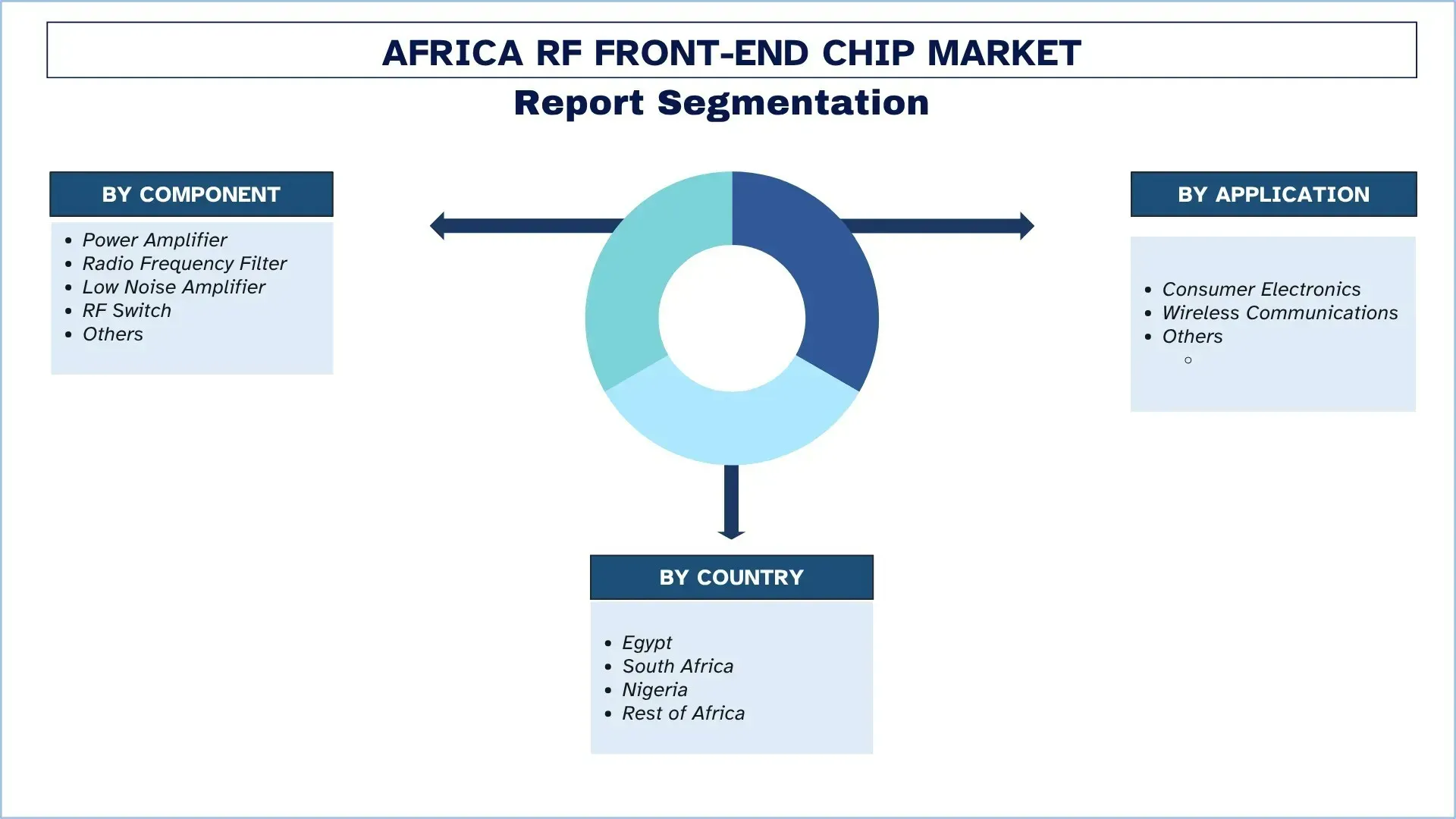- Home
- About Us
- Industry
- Services
- Reading
- Contact Us
Africa RF Front-End Chip Market: Current Analysis and Forecast (2025-2033)
Emphasis By Component (Power Amplifier, Radio Frequency Filter, Low-Noise Amplifier, RF Switch, and Others), By Application (Consumer electronics, Wireless Communication, and Others), By Country (Egypt, South Africa, Nigeria, Rest of Africa)

Africa RF Front-End Chip Market Size & Forecast
The Africa RF Front-End Chip Market was valued at USD 300 million in 2024 and is expected to grow at a strong CAGR of around 10.60% during the forecast period (2025- 2033F). Broadband & fixed wireless access (FWA) growth in underserved regions, and IoT / M2M deployment in agriculture, utilities, and smart cities are some of the key factors that have contributed to the market rise.
Africa RF Front-End Chip Market Analysis
The market of the African RF front-end chip is experiencing significant growth, which is caused by both the rapid increase in the adoption of wireless communication technologies in the region and the active integration of smart devices. As telecom operators continue to increase their 4G and 5G networks, the need to use advanced RF components that facilitate efficient transmission of the signals is increasing. Moreover, the growth of the market is being solidified by the addition of more investments in the IoT infrastructure, automotive connectivity, and defense communication systems. Integration of energy-efficient and miniature RF systems is also emerging as a major concentration as the companies meet the demands of optimization in performance in the new economies of the African continent.
Africa RF Front-End Chip Market Trends
This section discusses the key market trends that are influencing the various segments of the Africa RF Front-End Chip market, as found by our team of research experts.
Integration & Miniaturization (multi-function RF modules):
The African RF Front-End Chip market is experiencing a strong momentum towards the trend of integration and miniaturization of its products due to the increasing demand for compact, energy-efficient, and high-performance communication systems. Manufacturers are also working on multi-function RF modules that have amplifiers, filters, and switches packed into a single unit that is not very large. This will contribute to the reliability of the system, lowering power consumption and decreasing the total production expenses. With the African telecom operators using more 4G and 5G infrastructure to support the increasing data speed and enhanced connectivity, integrated RF solutions are becoming fundamental. The trend is also associated with the fact that the region is rapidly moving to IoT and smartphones and smart appliances, where small, multifunctional components are important in the implementation of seamless wireless function and efficient design integration.
Key Market Segmentation:
This section provides an analysis of the key trends in each segment of the Africa RF Front-End Chip market report, along with forecasts at the country and regional levels for 2025-2033.
Power Amplifiers have shown promising growth in the RF Front-End Chip Market.
As per the component, the Africa RF Front-End Chip market has been segmented into power amplifier, radio frequency filter, low noise amplifier, RF switch, and others. Among them, the power amplifier division has occupied a significant market share. This supremacy is explained by its vital importance in increasing signal strength, higher transmission quality, and the development of the latest technologies of communication like 4G and 5G. Furthermore, the growing power amplifier market in the African region is also a result of rising demand for high-performance connectivity solutions and the rise in the popularity of smartphones and IoT devices.
Consumer Electronics category dominates the Africa RF Front-End Chip Market.
Based on application, the Africa RF Front-End Chip market is segmented into consumer electronics, wireless communications, and others. Of these, the consumer electronics category has held a major market share. Some of the major issues that have enhanced the increased market growth are the rapid uptake of smartphones, tablets, and smart wearable devices in the continent. Also, the expanding penetration of the internet, broadband services (mobile), and the growing demand for a connected home environment are driving the necessity of an effective RF front-end solution. There is also massive adoption in the consumer electronics segment in Africa that is being driven by continuous development in semiconductor technology and low-cost products.

Egypt is expected to grow at a considerable rate during the forecast period.
The market of the Egypt RF Front-End Chip is growing very well, as the telecommunications infrastructure is growing rapidly, and more people are using 4G and 5G networks. Increased usage of smartphones, IoT-based applications, and smart city projects is driving the market of RF components that offer the performance of efficient connectivity and signals. The local and international manufacturers are undertaking new technologies that would improve network reliability, such as the use of low-noise amplifiers, power amplifiers, and RF switches. The local electronics production and government programs promoting digital change are also invested in the development of the market. With the current modernization of the Egyptian communication ecosystem, the RF front-end chip market will experience immense improvement in performance, integration, and scalability in various industries.

Africa RF Front-End Chip Industry Competitive Landscape:
The Africa RF Front-End Chip market is competitive, with several global and international market players. The key players are adopting different growth strategies to enhance their market presence, such as partnerships, agreements, collaborations, new product launches, geographical expansions, and mergers and acquisitions.
Top Africa RF Front-End Chip Companies:
Some of the major players in the market are Broadcom Inc., Infineon Technologies AG, NXP Semiconductors NV, Qorvo Inc., Skyworks Solutions Inc., STMicroelectronics NV, TDK Corp, Texas Instruments Inc., and Qualcomm Technologies, Inc.
Africa RF Front-End Chip Market Report Coverage
Report Attribute | Details |
Base year | 2024 |
Forecast period | 2025-2033 |
Growth momentum | Accelerate at a CAGR of 10.60% |
Market size 2024 | USD 300 Million |
Country analysis | Egypt, South Africa, Nigeria, Rest of Africa |
Major contributing Country | Egypt is expected to dominate the market during the forecast period. |
Companies profiled | Broadcom Inc., Infineon Technologies AG, NXP Semiconductors NV, Qorvo Inc., Skyworks Solutions Inc., STMicroelectronics NV, TDK Corp, Texas Instruments Inc., and Qualcomm Technologies, Inc. |
Report Scope | Market Trends, Drivers, and Restraints; Revenue Estimation and Forecast; Segmentation Analysis; Demand and Supply Side Analysis; Competitive Landscape; Company Profiling |
Segments Covered | by Component, by Application, by Country |
Reasons to Buy the Africa RF Front-End Chip Market Report:
The study includes market sizing and forecasting analysis confirmed by authenticated key industry experts.
The report briefly reviews overall industry performance at a glance.
The report covers an in-depth analysis of prominent industry peers, primarily focusing on key business financials, type portfolios, expansion strategies, and recent developments.
Detailed examination of drivers, restraints, key trends, and opportunities prevailing in the industry.
The study comprehensively covers the market across different segments.
Deep dive Country-level analysis of the industry.
Customization Options:
The Africa RF Front-End Chip market can further be customized as per requirements or any other market segment. Besides this, UnivDatos understands that you may have your own business needs; hence, feel free to contact us to get a report that completely suits your requirements.
Table of Content
Research Methodology for the Africa RF Front-End Chip Market Analysis (2023-2033)
We analyzed the historical market, estimated the current market, and forecasted the future market of the Africa RF Front-End Chip market to assess its application in major countries. We conducted exhaustive secondary research to gather historical market data and estimate the current market size. To validate these insights, we carefully reviewed numerous findings and assumptions. Additionally, we conducted in-depth primary interviews with industry experts across the RF Front-End Chip value chain. After validating market figures through these interviews, we used both top-down and bottom-up approaches to forecast the overall market size. We then employed market breakdown and data triangulation methods to estimate and analyze the market size of industry segments and sub-segments.
Market Engineering
We employed data triangulation techniques to finalize the overall market estimation and derive precise statistical numbers for each segment and sub-segment of the Africa RF Front-End Chip market. We split the data into several segments and sub-segments by analyzing various parameters and trends, by Component, by Application, and by country within the Africa RF Front-End Chip market.
The Main Objective of the Africa RF Front-End Chip Market Study
The study identifies current and future trends in the African RF Front-End Chip market, providing strategic insights for investors. It highlights Country-level market attractiveness, enabling industry participants to tap into untapped markets and gain a first-mover advantage. Other quantitative goals of the studies include:
Market Size Analysis: Assess the current forecast and market size of the Africa RF Front-End Chip market and its segments in terms of value (USD).
Africa RF Front-End Chip Market Segmentation: Segments in the study include areas by Component, by Application, and by
Regulatory Framework & Value Chain Analysis: Examine the regulatory framework, value chain, customer behavior, and competitive landscape of the Africa RF Front-End Chip industry.
Country Analysis: Conduct a detailed Country analysis for key areas such as Egypt, South Africa, Nigeria, and the Rest of Africa.
Company Profiles & Growth Strategies: Company profiles of the Africa RF Front-End Chip market and the growth strategies adopted by the market players to sustain the fast-growing market.
Frequently Asked Questions FAQs
Q1: What is the Africa RF Front-End Chip market’s current market size and growth potential?
The Africa RF Front-End Chip market was valued at 300 million in 2024 and is expected to grow at a CAGR of 10.60% during the forecast period (2025-2033).
Q2: Which segment has the largest share of the Africa RF Front-End Chip market by Component?
The Power Amplifier segment has occupied a significant share of the market. The supremacy of the power amplifier is explained by its vital importance in increasing the signal strength, higher transmission quality, and the development of the latest technologies of communication, like 4G and 5G.
Q3: What are the driving factors for the growth of the Africa RF Front-End Chip market?
• Broadband & Fixed Wireless Access (FWA) Growth in Underserved Regions: Rising demand for reliable connectivity in rural and remote areas is accelerating investments in RF front-end technologies to enable high-speed FWA networks.
• IoT / M2M Deployment in Agriculture, Utilities, and Smart Cities: Expanding use of IoT applications across sectors like precision farming, smart grids, and urban monitoring is fueling demand for efficient, low-power RF front-end chips.
Q4: What are the emerging technologies and trends in the Africa RF Front-End Chip market?
• Integration & Miniaturization (Multi-Function RF Modules): The market is shifting toward compact, multi-functional RF modules that combine amplifiers, filters, and switches for improved performance and reduced design complexity.
• Localization and Regional Supply Chain Development: There is a growing focus on establishing localized manufacturing and supply chain ecosystems to reduce import dependency and strengthen regional production capabilities.
Q5: What are the key challenges in the Africa RF Front-End Chip market?
• Infrastructure & Energy Constraints: Unreliable grid power, costly diesel, and limited RF-grade labs (shielded rooms, stable HVAC, clean power) raise OPEX and hurt test/yield. Weak fiber/logistics slow firmware/RF tuning and delay parts, forcing high safety stock.
• Market Fragmentation, Regulatory Inconsistency, Low Economies of Scale: Differing spectrum/type-approval rules across countries create per-market SKUs and re-cert cycles. Small, dispersed demand prevents volume pricing with foundries/OSATs and filter vendors, keeping unit costs high and sales/support burdensome.
Q6: Which country dominates the Africa RF Front-End Chip market?
Egypt has held a sizeable market share due to factors such as a bigger population, rising urban centers, consumer preference towards streaming and other broadcasting services. Additionally, the country is also home to a large internet and smartphone-using population, which has extensively supported the rise of RF Front-End Chip, as they are critical to the manufacturing of consumer electronics.
Q7: Who are the key players in the Africa RF Front-End Chip market?
Some of the top RF Front-End Chip companies in Africa include:
• Broadcom Inc.
• Infineon Technologies AG
• NXP Semiconductors NV
• Qorvo Inc.
• Skyworks Solutions Inc.
• STMicroelectronics NV
• TDK Cor
• Texas Instruments Inc.
• Qualcomm Technologies, Inc
Q8: What are the opportunities for companies within the Africa RF Front-End Chip market?
• Value Addition via Local Packaging, Testing, and Module Assembly: Developing regional capabilities in advanced semiconductor processes—such as packaging, testing, and module integration—can significantly enhance value capture and reduce reliance on imports.
• Targeting Niche Verticals (e.g., Smart Agriculture, Off-Grid Energy, Remote IoT): Expanding RF solutions into specialized applications like precision farming, decentralized energy networks, and remote IoT deployments offers high-growth potential in underserved segments.
Q9: How are consumer preferences shaping product development in the Africa RF Front-End Chip market?
Evolving consumer demand for affordable, energy-efficient, and compact devices is driving RF front-end chip innovation toward integrated, low-power, and regionally adaptable solutions tailored to Africa’s connectivity and performance needs.
Related Reports
Customers who bought this item also bought






